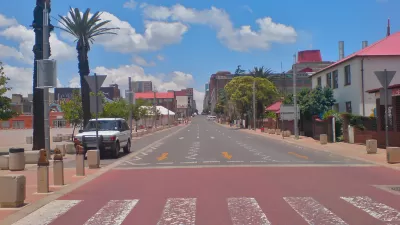Posh gated communities are juxtaposed with shanty towns in South Africa, where a constitutional housing guarantee is seen by many as a far-off dream.
"Despite the new Constitution's guarantee of access to housing for all, the stark class disparities in the townships that ring all the country's largest cities reveal the uneven process of remedying the inequalities institutionalized under apartheid, as a small number have benefited from "black empowerment" programs while the vast majority are still waiting their turn. When the African National Congress (ANC) came to power in South Africa's first democratic elections in 1994, more than 7 million people-almost all of them black-lacked adequate housing, according to the South African Human Rights Commission (SAHRC), itself a product of the new constitution. The ANC pledged to change this."
"South Africa's Department of Housing now claims on its Web site that it has built almost 2.4 million houses in the past twelve years. 'Our annual production has grown from 252,000 (which in itself was a record we were proud of), to 272,000 (and still counting), for the past year,' says Housing Minister Lindiwe Sisulu. 'We need to tell this good news, it portends a good future for millions still trapped in poverty, and it attests to the fact that the inhospitable firmament is clearing, and there will be better days.'"
"But while most South Africans say there has been progress under the ANC government, some are growing impatient with what they see as the slow pace of housing delivery, and a growing number worry that the promise of universal access to housing will not be met."
FULL STORY: A Housing Tour in South Africa

Maui's Vacation Rental Debate Turns Ugly
Verbal attacks, misinformation campaigns and fistfights plague a high-stakes debate to convert thousands of vacation rentals into long-term housing.

Planetizen Federal Action Tracker
A weekly monitor of how Trump’s orders and actions are impacting planners and planning in America.

In Urban Planning, AI Prompting Could be the New Design Thinking
Creativity has long been key to great urban design. What if we see AI as our new creative partner?

King County Supportive Housing Program Offers Hope for Unhoused Residents
The county is taking a ‘Housing First’ approach that prioritizes getting people into housing, then offering wraparound supportive services.

Researchers Use AI to Get Clearer Picture of US Housing
Analysts are using artificial intelligence to supercharge their research by allowing them to comb through data faster. Though these AI tools can be error prone, they save time and housing researchers are optimistic about the future.

Making Shared Micromobility More Inclusive
Cities and shared mobility system operators can do more to include people with disabilities in planning and operations, per a new report.
Urban Design for Planners 1: Software Tools
This six-course series explores essential urban design concepts using open source software and equips planners with the tools they need to participate fully in the urban design process.
Planning for Universal Design
Learn the tools for implementing Universal Design in planning regulations.
planning NEXT
Appalachian Highlands Housing Partners
Mpact (founded as Rail~Volution)
City of Camden Redevelopment Agency
City of Astoria
City of Portland
City of Laramie



























